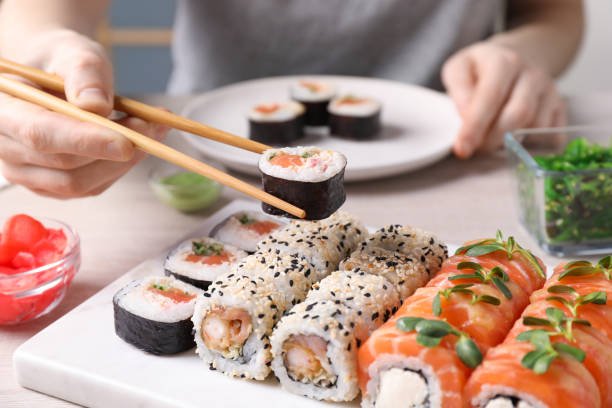Wednesday, 3 December 2025


Forty years ago, a bold initiative called Project Japan aimed to explore new opportunities for Norwegian seafood in the Japanese market. What started as a general trade mission evolved into a culinary breakthrough with the introduction of raw Norwegian salmon into sushi and sashimi, a concept that was virtually unheard of in Japan at the time. Today, Norwegian salmon has become a staple in sushi restaurants worldwide, reflecting the persistence, cultural exchange, and innovation that defined this project. As Norway celebrates 120 years of diplomatic relations with Japan and the 40th anniversary of this remarkable collaboration, Martin Skaug, Director of Communications at the Norwegian Seafood Council, shared insights in an interview with NUFFOODS Spectrum regarding the origins of Project Japan, the challenges of changing perceptions, and how this partnership has transformed global seafood consumption forever.
Looking back at the 1985 delegation to Japan, what were the initial goals of the mission, and how did the idea of introducing raw Norwegian salmon for sushi eventually take shape?
Initially, Project Japan was about finding opportunities for seafood in general and building a trading relationship between Norway and Japan. The idea of introducing Norwegian salmon in the form of sushi and sashimi came some years later. Research and analysis of the Japanese market at the time showed that there could be possibilities in the raw segment.
At the time, the use of raw salmon in sushi was virtually unheard of in Japan. What were some of the biggest challenges you faced in shifting perception and gaining acceptance among Japanese chefs and consumers?
Some of the biggest challenges were simply changing the idea that salmon is not fit for sushi, as the salmon Japan was used to was different from Norwegian salmon
Norwegian farmed Atlantic salmon was safe to eat raw as it is free of parasites, which was not the case for the wild-caught Pacific salmon that the Japanese were used to. Shifting this perception entailed many years of work, as well as cooperation with Japanese chefs, retail and other marketing initiatives, and hard work from the people involved in the project.
“Project Japan” is now considered a landmark initiative in global food diplomacy. Could you share how the project evolved in the years following its inception and what triggered the focus on sushi and sashimi?
Initially, the project was about finding opportunities for seafood exports in general. Some years down the line, the opportunity to introduce Norwegian salmon presented itself, in part because Norway had a lot of salmon that could be exported. One of the members of the Project Japan group, Bjørn Eirik Olsen, suggested that Norwegian salmon could be a good fit for the raw fish segment.
As the project evolved, one of the developments was the introduction of Norwegian salmon to so-called “kaiten sushi” (revolving sushi). This became a contribution to its success. It made it possible for the kids themselves to pick their own seafood nigiri. Many picked Norwegian salmon because of its beautiful pink colour, and when the kids liked it, the parents also had to taste it.
How significant has Japan been in transforming Norwegian salmon into a global ingredient? Do you believe this cultural collaboration has changed how seafood is consumed around the world?
The story of the introduction of Norwegian salmon to Japan is a great story in any culinary collaboration. Few products have made the Japanese kitchen so popular abroad as Norwegian salmon, and Norwegian salmon would not be as popular as it is without sushi and sashimi. In that way, Japan has been crucial for Norwegian salmon as a global product.
There’s no doubt this has all changed the way Norwegian salmon is consumed, and since it is exported to over 100 markets, one could say it has changed how seafood is consumed around the world. The popularity of sushi itself, with the help of Norwegian salmon, has made raw consumption popular all over the world as well.
Today, Norwegian salmon is part of many different dishes around the world. Norwegian salmon is equally suited for raw or steamed consumption, which are popular ways of serving in Asia. In the French market, smoked Norwegian salmon is a big favourite. In the US, barbequed Norwegian salmon is a popular choice.
Forty years since that first mission, how is the NSC commemorating this anniversary, and what message would you like to share with the new generation of sushi lovers globally?
This year, Norway is celebrating 120 years of diplomatic ties between Norway and Japan and 40 years of cooperation between the Japanese sushi kitchen and Norwegian salmon worldwide. Norwegian salmon is now a global phenomenon, exported to over 100 countries.
To commemorate, we have adapted a shared history, exploring the Norwegian origin of salmon sushi. Our goal is to leverage this interesting history in many of our markets in different formats, really throughout the whole year of the 40-year anniversary of Project Japan. If there’s a message we would like to share through this, it is the value of sharing that lies in the heart of the story of salmon sushi. It’s the shared collaboration of Japanese food culture and cuisine, together with Norwegian quality seafood, that made salmon sushi what it is today.
With sustainability and traceability becoming increasingly important in the seafood trade, how is Norway ensuring that its salmon continues to meet the highest standards while staying accessible to global markets?
Sustainability and environmental responsibility are essential in production on all levels, as it is what ensure the longevity and transparency of the industry. In a world that is changing all the time, adapting, evolving and always striving for sustainable practice will help ensure that the industry continues to deliver. And Norway will continue to lead the charge on constant development of sustainable practices, assessing the status quo and looking for improvement where possible.
— Shraddha Warde (shraddha.warde@mmactiv.com )